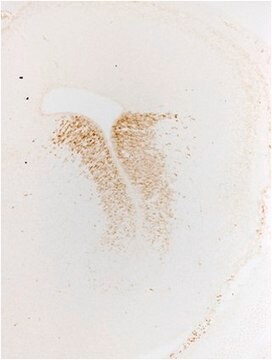AB1511
Anti-Glutamate Decarboxylase 65 & 67 Antibody
Chemicon®, from rabbit
Sinonimo/i:
65 kDa glutamic acid decarboxylase, Glutamate decarboxylase 65 kDa isoform, Glutamate decarboxylase-2 (pancreas), glutamate decarboxylase 2, glutamate decarboxylase 2 (pancreatic islets and brain,65kD), glutamate decarboxylase 2 (pancreatic islets and br
About This Item
Prodotti consigliati
Origine biologica
rabbit
Forma dell’anticorpo
saturated ammonium sulfate (SAS) precipitated
Tipo di anticorpo
primary antibodies
Clone
polyclonal
Reattività contro le specie
mouse, feline, rat, human
Produttore/marchio commerciale
Chemicon®
tecniche
immunohistochemistry: suitable
western blot: suitable
N° accesso NCBI
N° accesso UniProt
Condizioni di spedizione
dry ice
modifica post-traduzionali bersaglio
unmodified
Informazioni sul gene
human ... GAD2(2572)
Descrizione generale
Specificità
Western blot reveals a doublet at approximately 65/68 kDa.
Immunohistochemical staining can be abolished by preincubation with 1-10 μg peptide (Catalog Number AG252) per mL of diluted antibody.
Immunogeno
Applicazioni
1:200-1:5,000 dilution of a previous lot was used in immunohistochemistry (overnight PAP or ABC). Several fixative solutions may be used. Aldehyde-combination fixatives (i.e. those containing formaldehyde and glutaraldehyde) usually give satisfactory results. Bouin and Susa fixatives containing 0.1-0.2% glutaraldehyde have been used satisfactorily. Also reactive on paraffin embedded tissue. Protease digestion is not required.
Optimal working dilutions must be determined by the end user.
Neuroscience
Neurotransmitters & Receptors
Neuronal & Glial Markers
Qualità
Western Blot Analysis:
1:500 dilution of this antibody detected GAD 65&67 on 10 μg of mouse brain lysates.
Descrizione del bersaglio
Stato fisico
Stoccaggio e stabilità
Handling Recommendations: Upon first thaw, and prior to removing the cap, centrifuge the vial and gently mix the solution. Aliquot into microcentrifuge tubes and store at -20°C. Avoid repeated freeze/thaw cycles, which may damage IgG and affect product performance.
Risultati analitici
Whole rat brain lysate, mouse brain cell extract.
Altre note
Note legali
Esclusione di responsabilità
Non trovi il prodotto giusto?
Prova il nostro Motore di ricerca dei prodotti.
Raccomandato
Codice della classe di stoccaggio
12 - Non Combustible Liquids
Classe di pericolosità dell'acqua (WGK)
WGK 1
Punto d’infiammabilità (°F)
Not applicable
Punto d’infiammabilità (°C)
Not applicable
Certificati d'analisi (COA)
Cerca il Certificati d'analisi (COA) digitando il numero di lotto/batch corrispondente. I numeri di lotto o di batch sono stampati sull'etichetta dei prodotti dopo la parola ‘Lotto’ o ‘Batch’.
Possiedi già questo prodotto?
I documenti relativi ai prodotti acquistati recentemente sono disponibili nell’Archivio dei documenti.
Il team dei nostri ricercatori vanta grande esperienza in tutte le aree della ricerca quali Life Science, scienza dei materiali, sintesi chimica, cromatografia, discipline analitiche, ecc..
Contatta l'Assistenza Tecnica.








